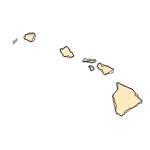Cuora amboinensis
(Southeast Asian Box Turtle)
Reptiles-Turtles
Exotic |
|
Common name: Southeast Asian Box Turtle
Taxonomy: available through
www.itis.gov
Identification: The best identifying characteristic of Cuora amboinensis is the wide yellow line running from the front of the head above the nostrils and eyes and along the neck. Similar to North American Box Turtles (genus Terrapene), all Cuora spp. have a hinged plastron (or lower shell) allowing them to almost completely seal their shells from predators. Their shells are not as domed as North American Box Turtles, but are more domed than most other aquatic turtles (Bonin et al. 2006).
Size: 250 mm
Native Range: Southeast Asia from Bangladesh to Indonesia and the Philippines (Bonin et al. 2006).



|

Alaska |

Hawaii |

Puerto Rico &
Virgin Islands |

Guam Saipan |
Hydrologic Unit Codes (HUCs) Explained
Interactive maps: Point Distribution Maps
Nonindigenous Occurrences:
Table 1. States with nonindigenous occurrences, the earliest and latest observations in each state, and the tally and names of HUCs with observations†. Names and dates are hyperlinked to their relevant specimen records. The list of references for all nonindigenous occurrences of Cuora amboinensis are found here.
Table last updated 12/19/2025
† Populations may not be currently present.
Ecology: Cuora amboinensis are primarily aquatic, being found in swamps and small water bodies as well as rice paddies, but will also move and feed on land. Mostly herbivorous, they also eat mollusks, crustaceans, and other invertebrates (Bonin et al. 2006).
Means of Introduction: Probable released pet.
Impact of Introduction: The impacts of this species are currently unknown, as no studies have been done to determine how it has affected ecosystems in the invaded range. The absence of data does not equate to lack of effects. Research is required to evaluate effects before conclusions can be made.
References: (click for full references)
Bonin, F., B. Devaux, and A. Dupre. 2006. Turtles of the World. The John Hopkins University Press, Baltimore, MD.
Author:
Freedman, J.A.
Revision Date: 5/20/2022
Citation Information:
Freedman, J.A., 2025, Cuora amboinensis (Riche in Daudin, 1801): U.S. Geological Survey, Nonindigenous Aquatic Species Database, Gainesville, FL, https://nas.er.usgs.gov/queries/FactSheet.aspx?speciesID=3807, Revision Date: 5/20/2022, Access Date: 12/19/2025
This information is preliminary or provisional and is subject to revision. It is being provided to meet the need for timely best science. The information has not received final approval by the U.S. Geological Survey (USGS) and is provided on the condition that neither the USGS nor the U.S. Government shall be held liable for any damages resulting from the authorized or unauthorized use of the information.